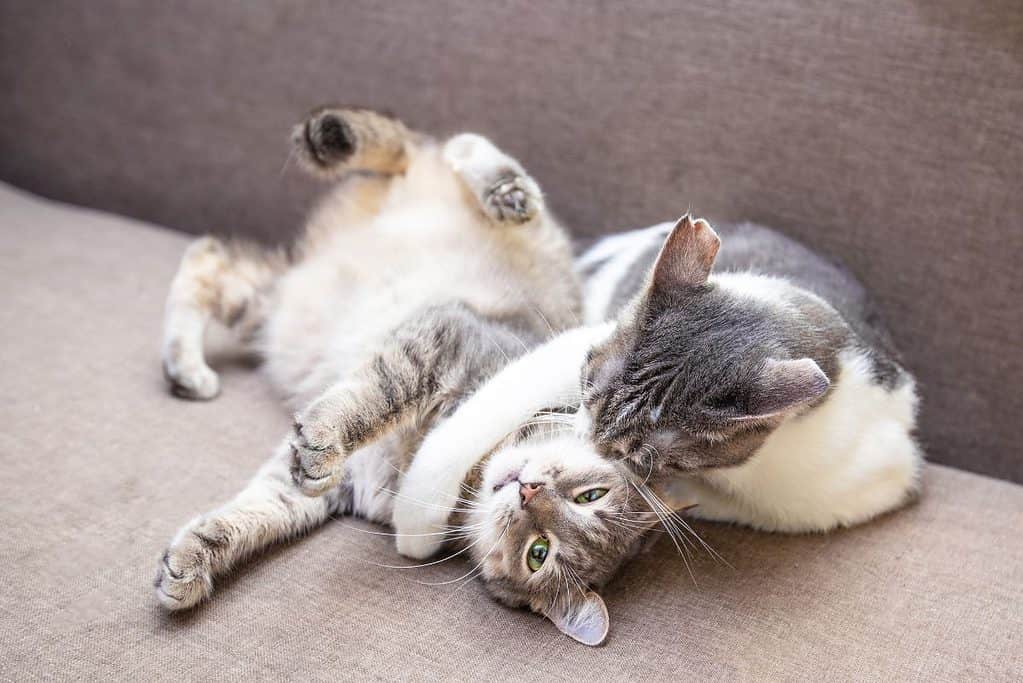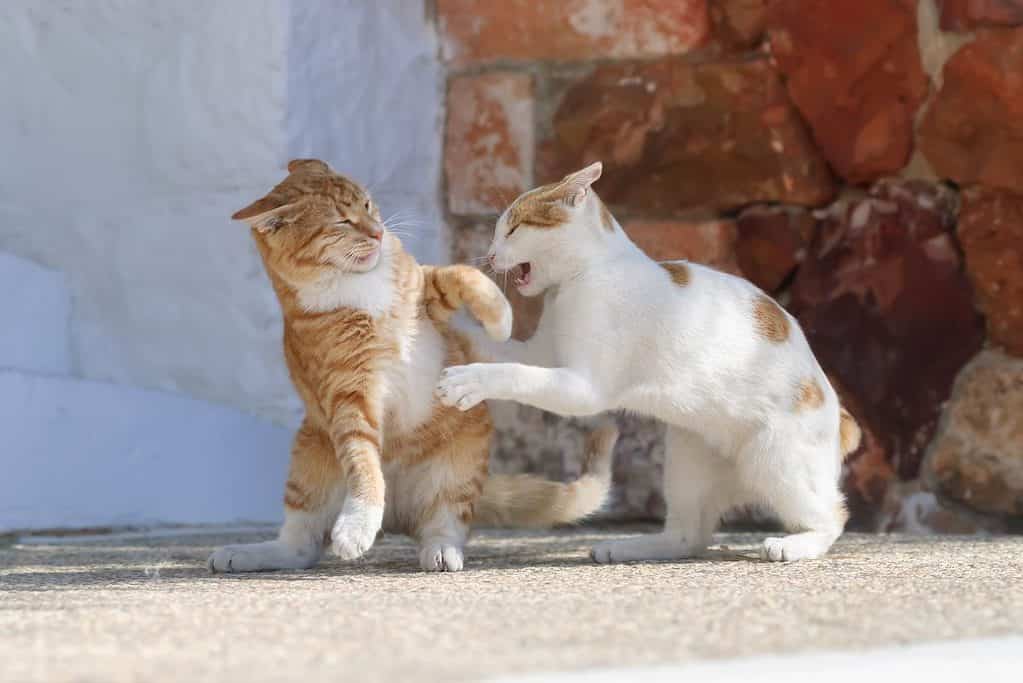When they were younger, my two female cats would dash around the house, jumping and tumbling with each other. Large tuffs of black fur could be seen all around.
While the sight of two cats crashing against walls might be alarming at first, this was just the rough and tumble way my cats loved to play with each other. At the first sound of any alarmed squeaking from my smaller cat, my large gray tabby cat would immediately jump off her mate.
It can be confusing when you first see two cats playing with each other. Playing is one way that kittens learn how to hunt so often the actions mimic hunting and fight behavior.
There are some clues in body language and vocalization of your cats you can observe to figure out if they are playing or if your cats are fighting each other.
Relaxed body language
One of the most obvious ways to tell if cats are fighting or playing is to observe their body language.

When cats are playing, they tend to have a more relaxed posture, with their tails held high and their ears facing forward.
During play, often one cat is on the ground with their belly exposed while the other cat is hovering over them. This is a vulnerable position for a cat to be in so cats will only expose their belly if they are comfortable.
During play, cats may also move slowly and gently, with a playful expression on their faces. In contrast, fighting cats will stare intensely at each other.
When cats are fighting, their bodies are tense, with their tails held low and their ears flattened against their heads.
Fighting cats may also hiss, growl, spit, or make other aggressive noises.

Pattern of movements during cat play
Another way to tell if cats are fighting or playing is to pay attention to their movements.
Playing between cats tends to be reciprocal. This means that playful cats often take turns chasing each other and may alternate between attacking and running away.
Playing cats may also pounce on each other, but these pounces are usually soft and playful.
In contrast, when cats are fighting, their movements are more forceful and aggressive, with one cat typically pursuing the other.
Cat vocalizations during play
The sounds that cats make can also provide clues as to whether they are fighting or playing.
Playful cats may make chirping or purring noises, while aggressive cats may make growling, hissing, or yowling noises.
It’s important to note, however, that some cats may make similar noises during both play and aggression, so it’s important to look their body language and movements as well to interpret what the cat’s vocalizations mean. For example, my one cat likes to hiss at his toy balls when he is playing with them. He will also hiss in excitement when someone dangles a feather on a string in front of him.
It’s also important to consider the context in which the cats are interacting. If two cats have a history of getting along well, it’s more likely that their rough and tumble behavior is just play. However, if two cats are meeting for the first time, or if they have a history of conflicts, their behavior may be more aggressive in nature.
Watch: tips to understand if your cats are playing
Cat playing tends to be harmless, fighting can lead to injuries
Playful interactions between cats are generally harmless and do not result in injury. However, fights between cats can lead to serious injuries, and in some cases, may even result in the death of one of the cats.
When cats play, their claws are sheathed and biting is done without pressure. Cats who have been fighting will have puncture wounds in their skin from the other cat’s claws and teeth.
Playing cats also tend to react to any sounds of discomfort by the other cat and, unlike cats who are fighting, will move away from a cat who is upset.
Playing helps cats to bond and develop social skills
Playful interactions also help cats to bond and develop social skills, while aggressive interactions can lead to fear, anxiety, and territorial disputes between cats.

When cats play together, they communicate through their body language, movements, and sounds. This helps them to learn how to read each other’s cues and respond appropriately. Over time, this helps them to build trust and understand each other’s boundaries.
Playing as kittens also helps cats to learn how to interact in a healthy way. If one kitten becomes too rough during play, the other kitten may retreat or communicate that it is not comfortable with the level of play. This helps kittens to learn how to respect each other’s boundaries and avoid aggressive behavior as they grow into adults.
Cats who were not properly socialized when they were kittens can develop pet aggression during play as adults. Kittens who played with other kittens quickly learning that biting hard hurts and will use bite inhibition during play to prevent injuries to their playmates.
Signs to look out for: cats playing
Here are some signs to look out for that can help you tell if a cat is playing:
- Relaxed body language: When a cat is playing with another cat, they usually have a relaxed body and may wiggle their tail or pounce around. They may also make chirping or meowing sounds.
- Softened claws: If a cat is playing, they may not extend their claws as they would during a fight. Instead, they may paw at their playmate with their claws sheathed or use their teeth without biting down.
- Mutual engagement: When cats play, they will often take turns being the “attacker” and the “defender”. If both cats are engaged and taking turns, it is likely that they are playing.
- Breaks in play: Cats may take short breaks during play to groom themselves or check their surroundings. If the cats take breaks without showing any signs of fear or aggression, it is a good indication that they are playing.
Cat playing versus fighting summary
Cats playing and fighting can look similar, but there are distinct differences between the two.
When cats are playing, they tend to have a relaxed posture with tails held high and ears facing forward, and they move slowly and gently with a playful expression. They may also make chirping or purring noises.
In contrast, when cats are fighting, they have a tense posture with tails held low and ears flattened against their heads, and they make aggressive noises such as growling or hissing. When cats are fighting their movements are also more forceful and aggressive, with one cat pursuing the other.
Observing body language, movements, and sounds can help distinguish between play and aggression in cats.
References
Delgado, M., & Hecht, J. (2019). A review of the development and functions of cat play, with future research considerations. Applied Animal Behaviour Science, 214, 1-17. https://doi.org/10.1016/j.applanim.2019.03.004
Gajdoš Kmecová, N., Pet’ková, B., Kottferová, J., Skurková, L., & Mills, D. S. (2021). Are These Cats Playing? A Closer Look at Social Play in Cats and Proposal for a Psychobiological Approach and Standard Terminology. Frontiers in Veterinary Science, 811. https://doi.org/10.3389/fvets.2021.712310
Gajdoš-Kmecová, N., Peťková, B., Kottferová, J., Halls, V., Haddon, C., de Assis, L. S., & Mills, D. S. (2023). An ethological analysis of close-contact inter-cat interactions determining if cats are playing, fighting, or something in between. Scientific Reports, 13(1), 92. https://doi.org/10.1038/s41598-022-26121-1
West, M. (1974). Social play in the domestic cat. American Zoologist, 14(1), 427-436. https://doi.org/10.1093/icb/14.1.427






